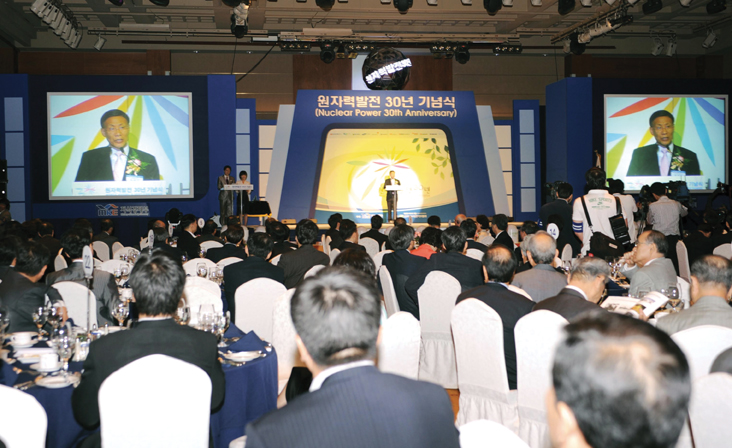Nuclear Power, Ultimate Option to
Cope with Sky-High Oil Prices
The nation, marking the 30th anniversary of domestic nuclear power, ranks sixth in the world in terms of capacity




Foreign and Korean nuclear power authorities and industry officials have concurred on the need for stepping up uses of nuclear power in order to address rising crude oil prices and climate change.
Prominent international and Korean nuclear power authorities as well as senior government officials assembled for a ceremony and an academic forum at the Grand InterContinental Hotel in Seoul on June 9 to celebrate Korea's 30 years of nuclear power generation. They shared the view that nuclear power should play a larger role.
In his speech, Prime Minister Han Seung-soo said, "korea should do its utmost to foster the nuclear power industry as a growth engine by making the most of the experiences and technologies it has so far accumulated and take the lead in the "nuclear power renaissance"era."
In 1978, the Kori Nuclear Power Unit 1 began commercial operation to become the second nuclear powerhouse in Asia following Japan. Korea now ranks sixth in the world with 20 units in operation with a combined capacity of 17,716MW.




The year 2008 also marks the 50th anniversary of Korea's launch of activities related to nuclear power.
The domestic nuclear power industry has so far generated 2 trillion kwh of electricity, cutting costs by 155.28 trillion won compared to petroleum or 247.2 trillion won compared to liquefied natural gas. As crude prices soar toward the $140-per-barrel mark, nuclear power's lower production costs have prompted calls for the construction of more nuclear power units. Nuclear power has emerged as the most feasible option in that such new and renewable energy sources as solar power and wind power are still a long way from being feasible.
With this trend in mind, the government is considering constructing nine to 13 more nuclear power units, each with a capacity of 1.4 million kw in order to raise the portion of the total electricity supply that nuclear power accounts for from the current 35.5 percent to 56 to 62 percent by 2030.
There are also obstacles to be overcome toward the construction of more nuclear power units. The government put the total expenditures for the construction of nine to 13 more nuclear power units, including those related to electricity transmission and distribution, at between 25.5 trillion won and 35.5 trillion won.
The Korea Hydro & Nuclear Power Co. has a low profit-making structure of producing electricity at a cost of 34 won per kwh and selling it for 39.4 won, which finds it difficult to secure such massive financing. Demands for the restructuring of an electricity charging system and diverse fund-raising measures, including private sector investments, have been mounting.
Another problem facing the domestic nuclear power industry is that the existing nuclear power complexes have space to build only six nuclear power units. The nation needs to speed up preparations for securing new nuclear power complexes to build seven or more units.
Korea should work out steps to expand the existing spent fuel storage facilities, which are expected to reach the saturation stage around 2016.
Taking a look into the 30-year history of the domestic nuclear power industry, nuclear power has become a prime mover behind the economic strides Korea has made so far. Electricity charges have almost remained unchanged. Figures released by Korea Hydro & Nuclear Power Co. showed that general prices shot up 199 percent during the 25-year period between 1982 and 2007, whereas electricity prices increased a meager 3.3 percent during the same period. Nuclear power is the most economical energy source. As of Dec. 31, 2007, nuclear power's unit price was lowest at 35.11 won per kw, followed by bituminous coal (37.7 won), combined cycle (101.46 won) and petroleum (117.41 won).
The domestic nuclear power industry has performed feats in almost every field of nuclear power including design, materials manufacturing, fuel supply and maintenance.
Kori Unit 1 has recently been allowed to stay in operation for another 10 years after its 30-year design life expired. Korea has also just begun a project to build a low- and intermediate-level radwaste treatment facility in Gyeongju City, solving a thorny issue that had been delayed by public disputes regarding the safety of the projected facility.
Korea is now striving to develop the Generation IV Nuclear System (G-IV) and pyroprocessing, a technology designed to process spent nuclear fuel.
In the latest feat of the Korean nuclear power industry, Doosan Heavy Industries & Construction has recently succeeded in winning an order to supply the main units of a new-type nuclear power plant in the United States, which is the first such order placed since the States'resumption of projects to build nuclear power units. Doosan signed a 300 million won contract with Westinghouse on May 8 to supply two reactors and four steam generators to what will be both the first new-type nuclear power unit in the United States and the first nuclear power facility to be built in that country after a 30-year hiatus. The projected power plant in Georgia will be a 1,100 MW-class AP1000, a third-generation pressured light water reactor type model developed by Westinghouse, whose safety and economic efficiency has been dramatically improved. The units will be manufactured at Doosan's plant in Changwon and delivered to the work site by March 2014. nw
Prime Minister Han Seung-soo, Vice Minister of Knowledge and Economy Lee Jae-hoon, MEST Vice Minister Park Jong-koo, and KHNP President and CEO Kim Jong-shin participate in a ceremony to mark 30 years of Korean nuclear power.
(far left, top) KHNP CEO Kim Jong-shin exchanges views with Prime Minister Han Seung-soo, on an inspection tour to an exhibition that coincided with the anniversary ceremony. The anniversary ceremony also held diverse events.
3Fl, 292-47, Shindang 6-dong, Chung-gu, Seoul, Korea 100-456
Tel : 82-2-2235-6114 / Fax : 82-2-2235-0799